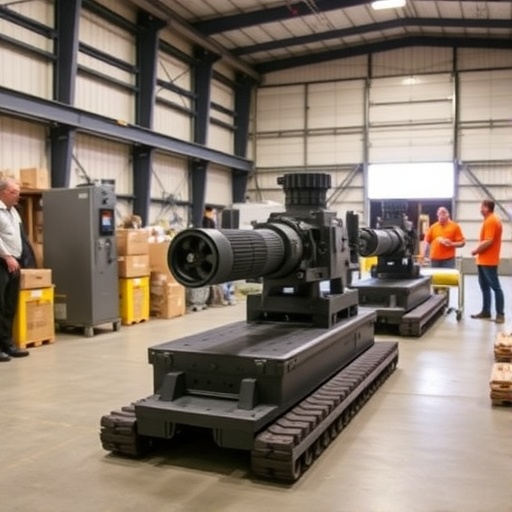In a groundbreaking advancement poised to redefine naval metallurgy and manufacturing, the University of Tennessee, Knoxville (UTK) has secured a significant $5 million grant from the Office of Naval Research to spearhead the development of next-generation military-grade steels. This ambitious interdisciplinary project is in collaboration with Mississippi State University and aims to revitalize and domesticize the United States’ capabilities in producing high-performance steels critical for submarine and naval ship hull construction. Through combining expertise in materials science, welding technology, and advanced manufacturing processes, the research promises to elevate the strength, durability, and weldability of steels integral to national defense.
The initiative addresses a crucial strategic gap; for decades, the U.S. has outsourced much of its military steel development overseas, risking supply chain vulnerabilities and technological stagnation. Eric Lass, an assistant professor of materials science at UTK’s renowned Tickle College of Engineering, underscores the national security implications of this research. He emphasizes that this work not only aims to innovate steel compositions tailored for naval demands but also ensures that these critical materials are developed, tested, and produced domestically. Moving away from reliance on foreign sources is a pivotal element of the project’s mission.
Central to this effort is the integration of advanced welding and additive manufacturing techniques that promise to transform traditional steel fabrication paradigms. The research team, including Professor Dayakar Penumadu, Fred N. Peebles Professor and IAMM Chair of Excellence at UTK, alongside Associate Professor Bradley Jared specializing in mechanical, aerospace, and biomedical engineering, is dedicated to pushing the boundaries of metallurgical science. Their collective focus lies in developing novel steel alloys with enhanced mechanical properties and tailoring welding methodologies that maximize joint integrity while minimizing defects and distortions.
One of the transformative technological pillars of this project is wire arc additive manufacturing (WAAM), an emerging process that enables precise, layer-by-layer deposition of metal. WAAM facilitates the creation of complex geometries and customized material structures in high-strength steel components, offering unparalleled advantage over traditional subtractive manufacturing processes. The UTK team’s efforts to optimize wire composition for WAAM applications are expected to significantly improve both the efficiency and quality of naval steel fabrication, potentially revolutionizing how ship hulls and submarine components are produced in the future.
An integral part of the development pipeline involves sophisticated multipass welding techniques designed to join thick steel plates—common in naval shipbuilding—with superior strength and resilience. Traditional welding of such thick sections presents challenges including residual stress accumulation, microstructural inhomogeneities, and thermal distortion, all of which can compromise the structural integrity of naval vessels. By innovating and refining welding parameters alongside the new steel compositions, the UTK-led team aims to mitigate these issues, thereby enhancing the performance and lifespan of critical naval infrastructure.
The project’s scope extends from fundamental research through to applied industrial upscaling. Initial metallurgical processing and validation activities will be conducted on the university campuses, leveraging their state-of-the-art laboratories and characterization tools. To transition from laboratory scale to real-world application, larger quantity production and pilot-scale manufacturing will shift to the Rapid Applied Materials Processing (RAMP) laboratory located on U.S. Navy property at President’s Island in Memphis, Tennessee. This facility provides advanced instrumentation uniquely suited for scaling additive manufacturing and welding processes.
Collaboration with the Oak Ridge National Laboratory (ORNL) plays an indispensable role in augmenting the capabilities of the project. Renowned for its cutting-edge research infrastructure and materials synthesis expertise, ORNL will assist in wire production and testing protocols. Such partnership enhances the depth of material characterization and process optimization, bringing the research closer to marine-industrial applicability and fostering a potential pathway toward certification and deployment within naval supply chains.
Funding from the U.S. Navy underscores the strategic importance of this program, reflecting a renewed commitment to domestic innovation in defense materials technology. James Andes, director of national security research initiatives at UTK, asserts that this investment not only advances metallurgical research but also bolsters manufacturing innovation in sectors frequently overlooked yet vital to the future of defense industrial base capabilities. The synergy of governmental support, academia, and national labs creates a fertile environment for sustained breakthroughs.
The project unfolds across a three-year timeline with well-defined milestones. In the initial year, the focus centers around collaborative development efforts on wire production and experimentally exploring the nuances of multipass welding and additive manufacturing of high-strength steels. Progressing into the second year, the team concentrates on formulating new wire compositions optimized for welding performance and additive manufacturing efficiency. By the third year, the culmination of research efforts will integrate these novel wires with freshly developed steel plates, demonstrating welded joints with enhanced mechanical properties suitable for naval applications.
Mississippi State University contributes significantly by advancing the design and production of stronger, lighter steel plates, while incorporating data science methodologies to analyze vast experimental datasets generated throughout the project. This fusion of materials science with computational analytics accelerates understanding of microstructural-development-property relationships, enabling rapid iteration and refinement. Such interinstitutional collaboration exemplifies the multidisciplinary nature necessary for technological breakthroughs in modern materials engineering.
The ultimate goal of this research extends beyond just naval steel production; it signals a renaissance in metallurgical innovation through additive manufacturing and welding technologies. According to Lass, metallurgy has long been regarded as a mature field, yet the integration of emerging manufacturing methods unveils unprecedented opportunities. Success in this initiative not only enhances national security but also establishes a technological foundation for broader applications, potentially transforming industries reliant on advanced metal fabrications and heralding a new era of American manufacturing leadership.
Subject of Research: Development of next-generation military-grade steel for U.S. Navy applications using advanced metallurgy, welding, and additive manufacturing techniques.
Article Title: University of Tennessee Receives $5 Million to Revolutionize Military Steel Fabrication with Advanced Manufacturing
News Publication Date: Information not specified
Web References: https://tickle.utk.edu/
Image Credits: University of Tennessee
Keywords: Manufacturing, Metallurgy, Steelmaking, Welding




